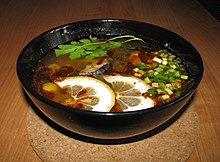Soljanka
Soljanka [ sɐˈlʲankə ] is a sour, spicy soup of Eastern European cuisine . The Solyanka combines shi (cabbage, sour cream) and rassolnik (pickled cucumbers, pickle brine); using vinegar instead of pickle broth is considered "bad cooking". Liquid and solid components of the soup are prepared separately and only combined a few minutes before serving.
etymology
In the Russian language the Soljanka was called seljanka until the end of the 19th century , derived from сельский ( sel'skij ) "rural, from the country" or село ( selo ) "village", and initially referred to very different rural dishes, like hot soup with meat or fish, cabbage, cucumber, onions, to bread with eggs. The name changed to "Soljanka" because finally numerous salt products ( соль ( sol ) "salt") were used for the preparation. The exact etymology is controversial. In addition to the name, the recipes have also changed. In cookbooks of the 18th century, only fisholyanka was described as "seljanka". The character of the Solyanka changed most when tomatoes or tomato paste were used in the preparation.
preparation
Today there are essentially three types of food, depending on whether meat, fish or mushrooms are the predominant ingredients. Common to all is that they with pickled vegetables, such as spices and pickles , mixed pickles are prepared or fungi.
For example, ham or bacon are fried with onions . In addition, there are strips of vegetables and roasted meat, rarely sausage and tomato paste . Then it is topped up with meat stock or fish stock and, depending on the recipe, pickled cucumber broth . After a short cooking time, the soup is seasoned with salt , pepper and, more rarely, paprika as well as fresh herbs such as dill , parsley and celery . For the fish soljanka, freshwater fish and possibly crayfish are used instead of meat ; in the mushroom soljanka - in addition to mushrooms - fresh vegetables such as white cabbage and carrots , as well as potatoes. Just before consumption, the soup is seasoned with lemon and sour cream . Capers and olives are possible additions.
distribution
Contrary to popular recipe names, the solyanka is traditionally not found in Ukrainian and Belarusian cuisine. Besides Russia, Solyanka is also known in many Eastern European countries today. In Germany, the soup is particularly widespread in the East, as Soljanka was one of the most popular stews in GDR gastronomy . It was mainly served here as a starter.
Web links
Individual evidence
- ↑ a b W. W. Pochljobkin : National Kitchen: The culinary art of the Soviet peoples . 2nd Edition. Verlag MIR, Verlag für die Frau , Moscow, Leipzig 1988, ISBN 3-7304-0053-3 .
- ↑ L. Ya. Starovoyt, MS Kosovenko, Zh. M. Smyrnova: Kulinariya . Vyshcha shkola, Kiev 1992, p. 80 (Ukrainian: Кулінарія .).

